
Its History, Legends and Lore / by Dorothy V. Corson

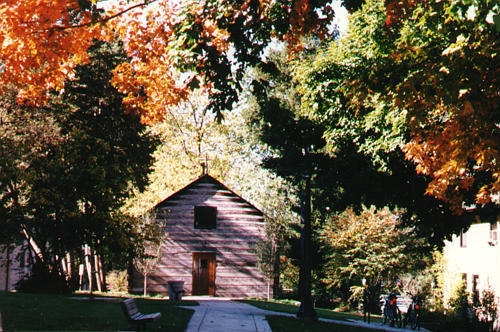
From the moment the replica of Badin’s original Log Chapel was completed and dedicated 100 years ago it has become a sacred place filled with sacred memories. Countless weddings, baptisms, and the renewal of wedding vows, have taken place within its hallowed walls. Among them is this little known story lost in time. It appeared in the Notre Dame Scholastic on March 29, 1957 and surfaced again fifty years later in 2007.
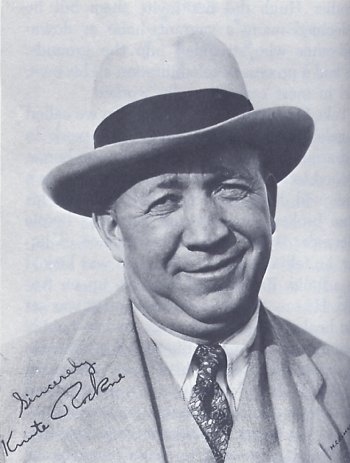
John McMahon is a junior journalism major. The following is the story of Knute Rockne’s Baptism written especially for this memorial to ”the Rock.”
He would follow the team into the little Catholic Church across from Grand Central Station when they went to New York to play Army. He would see his boys get up early on the morning of a game, steal from the hotel lobby and head for a church. His wife, who was converted before their marriage, was understanding in her Catholic example around their children. He was in constant contact with priests and clean Catholic boys at Notre Dame. It is probably a combination of all these that prompted Knute Rockne to become a Catholic.
It was 1925, the year after the Four Horsemen and the Seven Mules. Boys named Christie Flanagan, Joe Boland, Captain Clem Crowe and Arthur Boeringer perspired under his tutoring. Rock was being instructed by Father Vince Mooney, a close friend, and a priest at Notre Dame. Father Mooney tells how Rock was quick and eager to learn. How on many occasions, the Norwegian would stop him with questions on the Catholic Faith. He once asked Father Vince whom he called “Scotty,” just what the story was on the Modernists and Fundamentalists, two groups that had crept silently into the Church causing some trouble during the twenties. Father Vince was floored. Even he knew very little about it.
“I caught you off-sides, Scotty. If I were refereeing the game,” the Rock said, “I’d penalize them both half the distance to the goal and then start the game over.”
Father Mooney said Rock learned his religion by knowing football. He had the Seven Sacraments for a line and a backfield consisting of Faith, Hope and Charity and the All-American quarterback Justice.
The Baptism was set for November 20, the day before the Northwestern game. Northwestern, an unusually powerful eleven that year, hoped to be the first team ever to beat Notre Dame inside the confines of the green-fenced Cartier Field.
No one knew that Rockne was under instruction except his wife, Bonnie, and Father Mooney. Somehow several of the players got the rumor and came to ask Father Vince if they could be present for the ceremony. He relayed their message to Bonnie and she approached Rock.
“So they want to be at my Baptism,” he said. “What do they think this is, a three-ring circus? Tell them to go say their prayers.”
On a bright fall afternoon, Rock, Bonnie, Father Vince and Mr. and Mrs. Thomas Hickey, neighbors of the Rocknes, who were to be Rock’s sponsors, entered the Log Chapel on the campus. [The Hickeys were also Knute Rockne, Jr.'s Godparents.] The afternoon sun seemed to be setting in the old building, illuminating it entirely.
Father Vince began arranging the oils, cotton and the Baptismal font for the ceremony. He asked Rock if he would light the single blessed candle on the table before the font. Obediently the coach reached for the matches and marched toward the table. He looked to the rustic altar where several Benediction Candelabra stood guarding the tabernacle. “How ‘bout those, Scotty. Do you want me to light those?”
“If you were a priest or a bishop,” Father Vince answered, “we would light all the candles in the church, but you’re just an ordinary football coach. Rock turned and looked at the priest. “It looks to me, Scotty, like you’re pretty damn tight with the wax.” Stooping before the solitary candle, he ignited it with a satisfied grin.
Rock stood before the font and the ceremony began. The sun drove through the window, reflecting on his bald head. “OK, Scotty, go ahead. You won’t have to use much water.”
After the baptism, Father Vince took Rock by the arm. “Why don’t we step into the sacristy where we’ll have a little privacy, and I’ll hear your confession.”
Rock grinned again. “Why don’t you hear it out here? Everybody knows my business anyhow.”
Rock’s First Communion was to follow the next morning in St. Edward’s Hall. At that time, St. Ed’s was a grade school and the chapel pews were designed in miniature for boys up to the eighth grade. It was also First Communion day for about 100 of Sister Aloysius’s six to ten-year-old boys. Knute Rockne, Jr., was a member of this group. He did not know that his father had been baptized. Sister Aloysius arranged the boys so that when they stepped out into the aisle to go up to receive, Knute Sr. and Knute Jr. would be side by side.
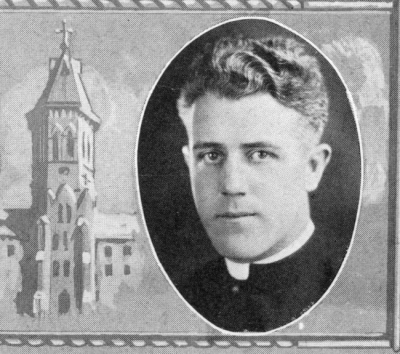
As Father Vince bowed low for the “Domine, non sum dignus . . . ,” the choir began singing “Oh Lord I Am Not Worthy.” Rock stepped in beside his young son, and slowly walked in procession to the Communion rail. A look came over Junior's face. “Daddy, go back,” he said. “You can’t come up here. This is for Catholics.” But Rock marched solemnly on. At the rail he knelt beside his son. “Daddy, go back,” said Junior again. “You’re not a Catholic. Go back.”
By this time, Father Vince was near them with the ciborium. He leaned down to the small boy. “I baptized your father yesterday afternoon,” he whispered. “Now he is going to receive his First Communion with you.” Admiration, surprise and pride swept over the boy’s face. He turned to his father smiling. “I’ll offer my Communion for you, Daddy,” he said.
That afternoon was also a great one for Rockne. The team knew that he was now a Catholic. Northwestern was playing as well as it had all season, and at the end of the half, were leading 10-0. In the dressing room between halves, Rock’s boys slumped to the floor to wait for an eruption from their coach.
“Good afternoon, ladies,” said Rock coming through the door. “So this is the Fighting Irish I’ve heard so much about. Well when you go out there in the second half and get the beating you deserve, I won’t share the disgrace with you. I will no longer be your coach,” Turning to his assistant coach, Hunk Anderson, he said: “You take ‘em, Hunk.”
Rockne left the dressing room and went up into the stands. He remained there for eight minutes. But that was long enough for the Fighting Irish to score two touchdowns. His boys won 13-10 on Cartier Field.
Maybe Rockne chuckled to himself. Anyway, he could never have lived out his threat if Notre Dame had lost that day. After all it was only the day before that he had become a real member of the team.
Rockne was baptized privately in the Log Chapel, with only his wife, his sponsors, and a priest present, little was known about it at the time. Less than six years later he would lose his life in a ill-fated plane crash. He was found clutching his rosary in his hand.
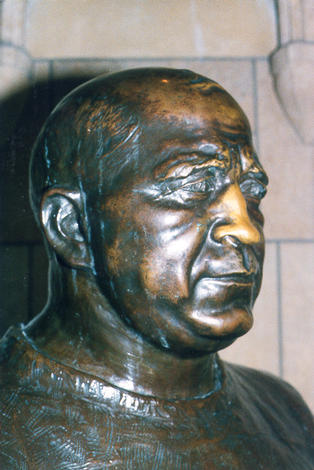
It has often been said that Time is the great healer of all wounds. Perhaps, but the wound that Notre Dame has suffered by the death of her most loved man will never be healed completely. Even now, after the nation has partially recovered from the passing of one of its greatest citizens, it is hard to realize what the loss of “Rock” means to us all.
Notre Dame without Rockne . . . the United States without Rockne, What does it mean? We hardly know, yet. The thousands of telegrams and letters received by the University are only partially indicative of the grief felt by the entire nation. It mattered not whether the newsboys in San Francisco or New York or Florida knew “Rock” personally; he was a friend to everyone and they loved him.
We at Notre Dame were closer to Rockne than anyone else; his very appearance on the campus made the world look brighter; his kind face, his soft smile, his cheery hello gave a thrill to all who spoke to “Rock.” And no one was ever intentionally snubbed. Rockne was that kind of a man—“a man’s man.”
Father O’Hara received a letter from the father of a crippled boy, who last year asked for a photograph of Rockne and got it, personally autographed. The little fellow heard the announcement of the air crash over the radio. He turned the radio off. When his father came home, his small son, with tears in his eyes, asked: “Daddy, will there be a Notre Dame now?” That is typical of the questions being asked by millions, young and old. And the only answer to the question is: “There will be a Notre Dame, a greater Notre Dame, because the spirit of the man who made Notre Dame famous will inspire her sons to greater heights, will drive them on to preserve the high ideals which their leader always advocated, because “Rock” will be watching, guiding, and praying for them to “carry on” where he left off—at the pinnacle of success.”
We shall remember Rockne because he wanted us to do the right things in the right way. Always clean, always fair, always fighting for the highest things in life. That was Rockne.
The above comments were taken from the Scholastic of April 17, 1931, which was dedicated to the memory of Knute Rockne.
Following my intuitive impulses throughout my research has kept me on that Trail of Memories to the very end as this postscript to the above story is a good example:
I doubt if anyone could read this story about Rockne without wondering, as I did, how a junior journalism student might have obtained this seemingly eye-witness account of Rockne’s private baptism. Would the writer still be alive after fifty years and still be listed in the Notre Dame Alumni directory? And would it be worth the effort to locate him? I was about to dismiss the idea when Fr. Hesburgh’s sage advice early in my research kept ringing in my ears; “You’ll never know if you don’t try.”
A quick call to a librarian friend at the Hesburgh Library reference desk resulted in only one remote possibility in a long list of McMahon’s. Would the telephone number be current and would he be alive fifty years later? It seemed worth a try.
As hard as it was to believe, on his end and on mine, not only did the number connect but at the other end of the line was the John Francis McMahon I was searching for—-and on the first try, no less!
He even shared a touching story about how he happened to write the article. This is what he told me about the extraordinary circumstances that inspired him to record this heart-warming story about Rockne. It is exactly the way he wrote it.
When John was a student of journalism on campus in the late 50s, he worked for the Scholastic as a feature writer. He was also working about 20 hours a week as a student assistant in the Sports Publicity Dept. One day Charlie Callahan, head of Sports Publicity, told him he had two file cabinets that were jammed full of Rockne memorabilia, including numerous duplicates. He offered John the job of organizing the two file cabinets and discarding the duplicates.
In going through the papers in the Rockne files, John said he was stunned to find a newspaper article about Rockne written by his father when he worked at the New York Sun. It was titled: “How a Notre Dame man feels about Rockne’s death.” The discovery of an article written about Rockne by his deceased father meant a lot to him because his dad died when John was in high school. It energized his task and led to the discovery of information about Rockne's baptism in the Log Chapel which inspired him to write the 1957 article that turned up fifty years later during my research in 2007.
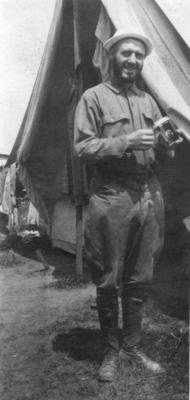
Father Vince Mooney entered the Army in 1942 at age 50. A month later, they switched him to a super-secret tank outfit on the desert in the Southwest. It was preparation for North Africa, Sicily and the rest of Europe. He was a rugged soldier and a kindly priest. Father Vince Mooney was "Padre" to the troops. He was a Chaplain with the following units, Adjutant Generals School, Ft. Washington AFRIC Ft. Knox, Ky; 9th Armored Group, 9th Air Force Headquarters from 1942-1946.
No chaplain ever was required to make 35 or 50-mile marches with the troops but men like Father Vince Mooney did. Father Mooney died on July 9, 1963, a little more than 32 years after his friend, Knute Rockne was buried.
"Tomorrow morning, they'll wheel Father Vince down the same aisle in Sacred Heart Church. And in that church where he began his priestly life, friends will gather to pay last respects to "one of the great ones" And we keep losing them all the time." -- Excerpts from "According to Doyle" by Joe Doyle, and from Father Vince Mooney's Indiana Province Archives Center files.Further details from Fr. Mooney's remembrances of Rockne turned up on one side of a single typewritten sheet among Father Mooney's archival papers:
At the top of the page is typed: Knute Rockne -- Fr. Mooney (at Holy Cross College banquet for Washington ND breakfast--1940). Fr. Mooney speaks of Rockne's prayer book which he carries with him all the time:
"When your secretary asked me to speak a few words about Knute, I was undecided what to speak on. As you know when the people found the bodies after the plane crash they were all mangled and twisted. They found this prayer book a few feet away from the body of Rockne. The crucifix on the rosary seemed to have been bent by force, as if someone was fiercely clinging to it. Both the prayer book and the rosary were sent back to his wife Bonnie and she gave them to me.
"Bonnie and I gave the prayer book to Knute when he was baptized. Today, when I give sermons, I read the Epistle and Gospel from it and build my sermon around this story. I have used it all over the country. It is very effective. A person out on the coast offered me $500 for that prayer book. Why? Once when Rockne was out on the coast, he went out of his way thirty five miles to visit a small high school. What for? To tell a student he was not doing right by his mother and dad. It is little things like that that made Rockne so popular. And this dad wanted to give the book to his son."
Fr. Mooney also alludes to the Baptism on this one page sheet. It follows closely the story in the above article, but in it are several additional personal details that describe Rockne's fun loving personality. He says, "Rockne could never refrain from wise-cracking, even during ceremonies."
"When the Baptism was progressing, Fr. Mooney told Bonnie that she could leave now, and he and Knute would finish it. 'Oh let them stay, everyone knows my business anyway.' Bonnie tried to make him keep quiet, but he was irrepressible. When Father got ready to baptize him, he ran his hand over his bald head: "Well anyway Scotty you won't have to use much water to baptize me, you old tightwad."
There is one other personal detail not noted in the John McMahon article. His son, Knute Rockne Junior, was called "Junie" by the family.
Fr. Mooney continues his remembrances about Rockne: "Whenever Rock went on a trip he always saw to it that he took his prayer book along. Why? He used to say that he was not well up on his religion as a Catholic and had a lot to learn. Bonnie invariably walked up to him before he left, and placed her index finger in his watch pocket to see if he was carrying his Rosary.
"He was always busy, but when he embraced religion, he was never too busy to be doing God's work. Rock was not perfect; none of us are. He had his own ideas how things should be run, but could take advice. He would listen to reason. He was a driver, but never unjust; always fair and impartial."
Obviously, Rockne's wise-cracking naturalness and his penchant for sometimes inventing gut-wrenching "win one for the gipper" stories to spur "his boys" to victory was what endeared him to millions of people all over the world.
The element of surprise, doing the unexpected, was always a part of Rockne's game plan. Now he is gone but the inspiration of his brief life on earth lives on.The message he left us can be summed up in two words: Be Yourself. That's one thing we can all do better than anyone else. The mass appeal of his extraordinary personality was--and still is--contagious.
 |
It’s the spirit that inspires Then memory becomes As the body is sustained Now he is “Going Home” |
When Bonnie Rockne passed away in 1957, Rockne's former home was purchased by a member of the Thomas Hickey family, who had been his good friends and sponsors. It has been lovingly cared for ever since.
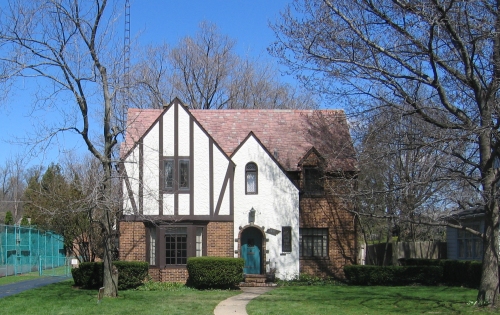
During the celebration of the Grotto's centenary in 1996 I learned, by chance, that the Log Chapel's centenary would be celebrated in 2006. Ten years seemed a long way off but I made a mental note to research its history when the time came, as I had done with the Grotto, never suspecting the time would fly by so quickly.
When 2006 arrived, I was in the midst of publishing a book version of my Internet manuscript A Cave of Candles: The Story Behind the Notre Dame Grotto -- The Spirit, History, Legends and Lore of Notre Dame and Saint Mary's. So I was delayed in checking the Hesburgh library stacks for more historical details on the Log Chapel's centenary, to pass on to those on campus who might be interested in celebrating the occasion. In going through the first 1906 Notre Dame Scholastic I took off the shelf, I learned to my wonderment that three centennials would be occurring in the years 2006-2007.
On May 3, 1906 two special events occurred that were observed with a double celebration, the dedication of Sorin's Monument, and the completion and dedication of the replica of the Log Chapel which I have detailed in the last two segments. As if the centenary of Sorin's Monument and the replica of Badin's Log Chapel were not enough to celebrate, The Dome Yearbook, also celebrates its centenary in 2006. Thus, coincidentally or providentially, three very special events occurred in tandem with one another. Obviously, 1906 and 1907 were banner years for Notre Dame.
I had been trying to alert the powers that be on campus about the upcoming Log Chapel centenary before I ever knew about the centenary of Sorin's Monument and the double celebration that occurred the day they were completed on campus. Why not another double celebration -- to mark the centenary of their arrival on campus -- 100 years later? It seemed a worthy cause. However, the Log Chapel centenary had not generated any interest and the anniversary year was winding to a close in the spring of 2007. It seemed a pity to let these events pass by without any recognition of the historical value of their presence on the Notre Dame campus.
The time clock on these three centennials kept ticking away, when another startling bit of news revived my determination to generate campus interest in these three lost in time events: A news release from the News and Information Department of the University crossed my path. And once more to my wonderment two more fascinating historical events of note were added to those I had already discovered: Father Basil Anthony Mary Moreau the Founding Father of the Holy Cross Order in France would be beatified in the Fall of 2007! That triggered another memory of his first and only trip to America to visit Notre Dame and St. Mary's. Until that moment, I hadn't thought about the timing of it until it dawned on me that August 1857 was 150 years ago.
Within the space of two years, 2006 and 2007, six celebratory events would be occurring: three centennials, a sesquicentennial, a beatification, and the 110th anniversary of the building of the Lourdes Grotto on the campus of Notre Dame, all of them in 2006 and 2007.
The previous three events in this segment -- the centenary of Sorin's Monument, the replica of the Log Chapel, and The Dome Yearbook -- all took place the same year, May 3, 1906 through May 3, 1907. It seems only fitting that they, and the sesquicentennial of Moreau's arrival in America on August,1857 -- which coincides with the date of his beatification 150 years later, on September 15, 2007 -- be celebrated together in memory of Father Basil Anthony Moreau.
I now invite all interested alumni, fans, and friends of Notre Dame and Saint Mary's to journey back in time with me to the summer of 1857, 150 years ago.
The following two events exemplify the life and times of Father Moreau in the middle of the 19 Century. I began working on them immediately, excited about stumbling upon, by chance, such a fascinating array of events for Notre Dame and Saint Mary's to celebrate in their 21st Century.
<< back | The Spirit of Notre Dame | next >>